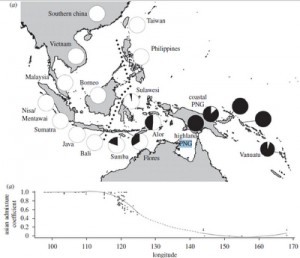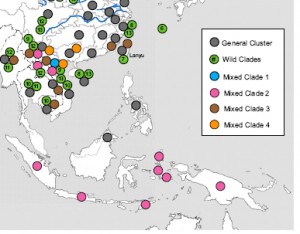- Japonica rice heads for the tropics for first time.
- Yet another Indian genebank opens its doors.
- And from somewhere else in India, we are alerted to the fact that today is International Seed Day.
- The biggest little olive farm in the world? Texas virgin on sale.
- Old endangered Norwegian cattle more efficient than modern breed. Genetics too.
- Foods, words, politics — a heady brew.
- Banana vs plantain. Jeremy says: Someone is wrong on the internet.
- Butterfly farming in Kenya under the spotlight. Again.
- Launch video of the expedition down the Congo river; agriculture only a pretty backdrop.
Vaccines, vitamins and er .. lemme see .. vital information!
Michael Specter is a staff writer for The New Yorker, has a book out called Denialism: How Irrational Thinking Hinders Scientific Progress, Harms the Planet, and Threatens Our Lives, and gave a recent TedTalk on The danger of science denial that has created quite a stir, most of it positive. And I’m mostly in accord.
People who refuse to vaccinate their children are indeed free-riding anti-social parasites, no matter what cockamamie reasons they give for their refusal, and those who aid and abet them by stoking fears about the dangers of vaccination are, if anything, worse, because their stupidity is a multiplier that endangers so many more of us.
And yes, people who spend (lots of) good money on vitamins and quack cures and other folderol that is not only not efficacious but sometimes downright harmful are indeed fools, easily parted from their money and probably suffering into the bargain, let alone the leeches who prey on them. 1
But — and here, at last, is where we approach the admittedly catholic tastes of this blog — when Specter turned to the denialism that, he says, condemns million of hungry people to miserable starvation and an early death, I got just the teeniest whiff of inconsistency. What were his chosen examples for the evidence-based decision-making that he wants us to embrace not only for vaccines and vitamins but also for the vital business of feeding people with GMOs? Golden rice and super-cassava.
I kid you not.
It’s true that modern rice varieties lack vitamin A precursors. It’s also true that golden rice 2.0 delivers more carotenoids than version 1.0. But so do many other foods that people can actually grow for themselves, that a diversified agriculture and diet can provide and that are almost certainly cheaper and more sustainable than golden rice. So where, precisely, is the evidence that golden rice is the best, or even a good, solution to the problem of vitamin A deficiency? Specter seems completely unaware that the alternatives even exist, let alone that they could be made available now, everywhere.
Likewise, Specter may not rate cassava all that highly, but the plant provides people with far, far more than the the “empty” calories that Specter assumes. For a start, cassava leaves are widely eaten, and supply many of the nutrients lacking in the tubers. I remember someone telling me that leaves infected with cassava mosaic virus may actually be more palatable and more nutritious than uninfected leaves (although I confess I cannot now find the details). Will one engineered super-cassava be suitable for all the places where it will be needed? How easy will it be to create the huge diversity of super-cassavas that Africa’s diverse growing conditions require?
Let me be absolutely clear. I am not against genetic engineering at all. How could I be, when it is only a tool? Indeed, I think that there are far more pressing problems than fortifying staples that deserve and are being denied a genetic engineering approach. I am not denying that one could deliver more vitamin A and other micronutrients by engineering rice and other staples. I am denying that this is the only way, or even a good way. We’ve been round and round these discussions here and elsewhere. What we really need, and what, I fear, Specter does not want, is a little more investment in the alternatives. It might even prove that I’m completely wrong. In which case I swear I’ll change my mind.
That’s how I use evidence.
Crossing the Wallace Line
Dienekes’ Anthropology Blog has an intriguing map from a paper on human genetic diversity in island South East Asia showing a sharp cline across Wallace’s Line.
The genetic cline corresponds to a cline in phenotype which was actually recognized by Wallace himself. 2 The authors…
…conclude that this phenotypic gradient probably reflects mixing of two long-separated ancestral source populations—one descended from the initial Melanesian-like inhabitants of the region, and the other related to Asian groups that immigrated during the Paleolithic and/or with the spread of agriculture. A higher frequency of Asian X-linked markers relative to autosomal markers throughout the transition zone suggests that the admixture process was sex-biased, either favouring a westward expansion of patrilocal Melanesian groups or an eastward expansion of matrilocal Asian immigrants. The matrilocal marriage practices that dominated early Austronesian societies may be one factor contributing to this observed sex bias in admixture rates.
There’s a map of the same region in the recent paper on pig domestication that’s been in the news lately.
Compare and contrast. Still two quite distinct populations, but the placing of the line of demarcation is somewhat different. This is what the authors have to say about the Pacific pigs, after their main discussion, which is of their separately domesticated Chinese cousins:
This genetic evidence also supports separate domestication pathways (however independent) of one population in India and three wild boar populations indigenous to Peninsular Southeast Asia. Given the relative geographic proximity of the Southeast Asian clades, it is possible that the domesticated haplotypes were all present in a single population of wild boar, as is the case for modern Yaks. Regardless, only the Pacific Clade domestic pigs were transported out of Southeast Asia (to ISEA and the Pacific) before they were replaced in their homeland by domestic pigs derived from nonindigenous populations of wild boar.
So, people and pigs moving together across Wallace’s Line. How about crops? There are also distinct Pacific and Asian genepools in taro, though I could not find a nice map to compare directly with the above. However, the consensus seems to be — as also for crops such as bananas, yams, breadfruit, sugarcane and yams — that domestication happened southeast of the Wallace Line, in Sahul (Melanesia to be exact). As my friend and colleague Vincent Lebot said of these crops a few years back 3:
We now have biomolecular evidence to suggest that most cultivars were not brought by the first settlers from the Indo-Malaysian region, but rather were domesticated from wild sources existing in the New Guinea and Melanesian areas… In other words, the first migrants that went across Wallacea did not embark major domesticated plants if any, in their adventure.
Pigs, in other words, and maybe chickens, but not taro or yams. Banana went in the opposite direction. I wonder why. Or did people bring them on their adventure, and abandon them when they found better varieties?
Incidentally, coconut also shows a bit of a Wallacean dividing line, but of course it doesn’t need humans for its dispersal, at least not everywhere.
Nibbles: Consortium?, Sheep diversity, Sustainable biofuels, Agroforestry, Almonds, Chicken breeding, Restoration, More tree management, Vegetable gardening, Wheat domestication
- IRRI tries to raise $300 million for rice in Asia. Including for that genebank of theirs?
- Sheep phylogeographic genetic structure weak, but not completely absent, thank goodness.
- Examples of sustainable biofuels. No snickering at the back there.
- How to manage tree genetic resources under climate change. By some friends.
- Almonds 101.
- “…testing the genetic and immunological limits of poultry.” And then eating the results.
- Grassland restoration needs to take into account functional diversity. And DNA?
- Presentation on community forestry management in Niger. Nice story.
- Senegalese vegetable farming project uses terra preta but modern seed. Go figure.
- Ancient farmers off the hook for loss of key wheat gene. Plant breeders to blame, apparently.
Nibbles: China, Andean roots and tubers, pigs, greenhouse gases, locavores, drought, mapping horticulture, 2010 Growing Green Awards, canker, World Bank, threats, cashmere
- China’s role in food price spikes. Books sounds worth reading.
- Dutch chefs easily fascinated. Just show ’em an Andean root or tuber.
- Much more on that pig domestication story.
- Global Research Alliance on Agricultural Greenhouse Gases agrees its agenda. In New Zealand. Jeremy avoids snarky remark.
- New York Times debates locavorism. Someone has to.
- Monsanto, DuPont Race to Win $2.7 Billion Drought-Corn Market. Africa says Yay!
- If you have an horticultural development project, Horticultural CRSP and GlobalHort want to hear from you.
- More environmental awards handed out. Recipients asked to blog.
- Chestnuts out of fire?
- Data!
- Really, who’d be a farmer?
- Chinese clone woollier cashmere goats. Why not just clone the wool directly, cut out the middleman?
- Tales of maize and tomato hybrids.

